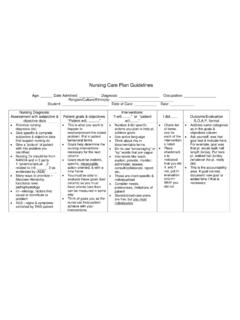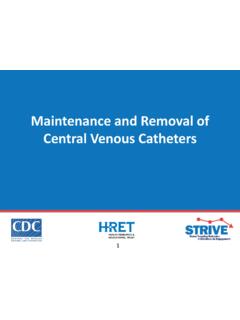Transcription of IV 03 Intravenous Therapy-General Guidelines - Craig …
1 IV 03 1 of 16 Craig HOSPITAL POLICY/PROCEDURE Approved: NPC, P P IC, MEC 03/07; NPC, P MEC 9/09 P MEC, P&P 01/11, 04/11 Effective Date: 10/78 Attachments: A = Care & Use of IV Catheters Revised Date: 12/02, 07/04, 10/04, 05/05, 12/06, 12/08, 06/09, 12/10, 04/11 Forms: SMC form - Picc Line placement Reviewed Date: SUBJECT: Intravenous therapy : general Guidelines RATIONALE: To assure safe and effective practices in all activities related to Intravenous therapy . SCOPE: Registered Nurses POLICY: Consistent care is established to assist with prevention of line sepsis and clotting EQUIPMENT: See individual sections POLICY: I. Patient identification is required prior to initiating Intravenous (IV) therapy or any changes with the current IV therapy plan per policy RI 11 Patient Identification. Patient identification will include two verifiers. II. RNs working with IV preparations will be familiar with aseptic technique.
2 III. IVs utilizing additives will be prepared in the pharmacy. IV. Good hand washing and standard precautions (gloves) should be used when accessing any IV site. V. IV sites should be assessed and findings documented at least BID in appropriate nursing documentation. Documentation should include; blood return, patency, appearance of site and for central lines length of catheters VI. The drug specific library will be used in situations where the smart programmable pumps are utilized. Hard upper limits will not be exceeded. PROCEDURE: IV 03 2 of 16 I. STARTING A PERIPHERAL IV A. RN will identify MD order for peripheral IV line 1. Restrictions on site of insertion: a. Not attempted in feet or legs of an adult without physician s order. b. Not attempted on the limb of a patient who has had axillary lymph nodes removed or who has A-V shunt without physician s order. c.
3 Not attempted on an extremity with a known blood clot. 2. When attempting IV insertion: a. No more than two unsuccessful attempts may be performed per nurse. b. If unable to accomplish insertion, notify clinical nurse coordinators, if available. B. RN will document IV insertion in appropriate nursing documentation (including IV site, type, gauge of catheter and number of attempts). C. A local anesthetic agent may be used when performing IV insertion unless patient refuses or use is contraindicated. D. Bacteriostatic sodium chloride (with Benzyl Alcohol) is the drug of choice. Up to cc. of Lidocaine without epinephrine may also be used (obtain order from physician). E. An extension is placed on the angiocath on all IV starts and restarts. Exception: Do not place extension on IV lines used for contrast injection by radiology.
4 F. Pre-op IV insertion will be started with #18 angiocath unless otherwise ordered, and macrodrip tubing. If unable to insert a #18 angiocath, document on pre-op check-list. II. ADMINISTRATION OF IV SOLUTIONS A. Peripheral IV sites will be changed by the RN every 96 hrs. and prn. EXCEPTION to changing site every 96 hours: 1. The site is asymptomatic 2. The patient has poor veins 3. The IV will be discontinued within 24 hrs 4. All of the above exceptions should be documented daily when the site is not changed. IV 03 3 of 16 B. RNs may administer IVs (maintenance and IV piggyback) via central lines. RNs only will dc central lines. C. RNs may initiate and discontinue peripheral IV catheters. D. The nurse hanging an IV solution will verify that the solution and additives are correct, that the solution is clear, without particulate, and the container is without leaks or cracks.
5 E. Bags of IV solution may be left hanging for no more than 72 hours. EXCEPTION to leaving solutions hanging for 72 hours: 1. Change TPN bag and tubing every 24 hours 2. Change Lipids bag and tubing every 24 hours 3. Change Albumin bag and tubing every 24 hours 4. A shorter period of time is specified by pharmacy. The RN hanging a new IV bag is responsible to date, time and initial the bag/label. F. Rate of infusion may be decreased following appropriate assessment of the patient's condition ( fluid overload, combined rate of continuous and IVPB is greater than recommended rate of infusion through peripheral or PICC line- See Attachment A). 1. Document and notify the physician of the change. 2. Keep-open rate is 20-25 cc. /hr. (use a 250 cc. or 500 cc. bag when hanging a KVO ). G. Arm boards 1. Should be used for IVs located in the antecubital space and prn 2. Should be used to facilitate delivery when a catheter is placed in an area of 3.
6 Extremity flexion 4. The arm board should be removed every 8 hours to assess the extremity status for circulation and pressure. H. Smart Programmable Pumps 1. When using the pumps the drug library must be selected. 2. Upper hard limits are concentration and policy restricted and can not be overridden. III. CHECKING IV INFUSIONS A. IV rounds will be made by the responsible nurse on each patient with an IV at the beginning of the shift to verify the following: 1. Correct patient IV 03 4 of 16 2. Correct solution. 3. Correct additives. 4. Correct rate of infusion. 5. Quantity of solution 6. Monitoring equipment appropriate. 7. Insertion site is free from infiltration redness, and positioning problems. 8. Tubing is current. 9. Length of time IV site in place. B. IV infusions are to be checked at least hourly as follows: 1.
7 Check rate, redness, swelling, pain, wet dressing, purulent discharge, thrombosis, or infiltration. Document findings of hourly assessments at least once a shift. 2. If symptoms present, discontinue IV and have appropriate person restart. 3. If purulent drainage is present notify the attending MD, remove the catheter and culture the site if physician s order received. 4. Fluid overload a. If more than 2 times the ordered fluid volume per hour is received by high risk patient complete an incident report form. b. If more than 3 times the ordered fluid volume per hour is received by non high risk patient, complete incident report form. c. High risk patients are defined as those patients requiring a pump, see section VIII. 5. Record discontinuation and a description of catheter site in appropriate nursing documentation and IV fluid on MAR. C. Dressing changes will be performed by an RN 1.
8 Document dressing changes in appropriate nursing documentation. 2. Dressings will be labeled with the date of insertion, initials of the person inserting, size of the catheter , date of the dressing change, and initials of person changing the dressing. 3. Peripheral line: gauze dressing, change every 48 hours. Transparent dressing: change only when dressing compromised or with line change. 4. Central Line: refer to attachment A 5. The IV site will be cleansed with 2% chlorhexidine. D. Parenteral solutions will be labeled to indicate the rate of infusion, the date, and time of starting the infusion. Do not write on IV bag/container or tubing. On IVs not given via an infusion pump: 1. Place masking tape along numbers on the bag. 2. Mark the hourly checkpoint, starting at the zero line. Piggyback IV 03 5 of 16 medications are included in the hourly total. 3. At the end of the shift, the amount marked as left in bottle should include amount remaining in soluset.
9 4. If the infusion is ahead or behind at the end of a shift, relabel the with new tape. IV. TUBINGS A. All IV tubing, claves, and 3-way adapters will be changed every 72 hours as a new bag of fluids is hung. Claves should also be changed after blood draws. EXCEPTION to changing tubing every 72 hours: 1. Change TPN and lipids every 24 hours 2. Change Albumin every 24 hours 3. Change Septra/Bactrim every dose 4. Blood and blood products see blood administration policy (IV 04) 5. Other drugs as specified by Pharmacy B. Label new tubing with a label near the top of the tubing showing the date and time of tubing change and initials of nurse who changed the tubing. C. Each secondary infusion (piggyback) will have its own tubing. 1. When patient is receiving only one kind of secondary infusion with a primary IV, leave the secondary line connected to the primary IV tubing. 2.
10 When patient has more than one secondary infusion, use a multi injection site and leave all secondary sets connected to primary IV tubing, this is the preferred method. Or disconnect the secondary set and cap after each infusion. 3. Change all secondary tubing at the same date and time as primary tubing even if secondary tubing is not due for change. V. FILTERS A. A micron filter will be used to administer antibiotics peripherally and on all fluids given via a central line. EXCEPTIONS TO USING FILTERS: 1. Patients going to surgery 2. Suspensions. (Amphoterician B and lipids). 3. Albumin 5. Protonix (Use filter provided by pharmacy) B. A micron filter is not needed for antibiotic administration of less than 24 hours duration. C. When a filter is used, place the filter at the end of the primary line on running IVs.







